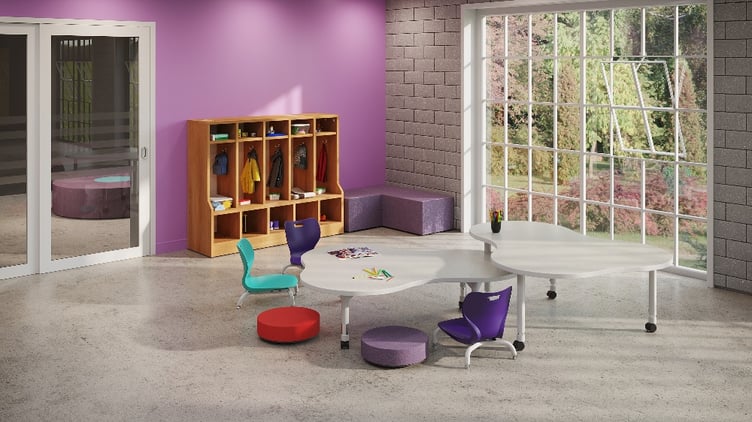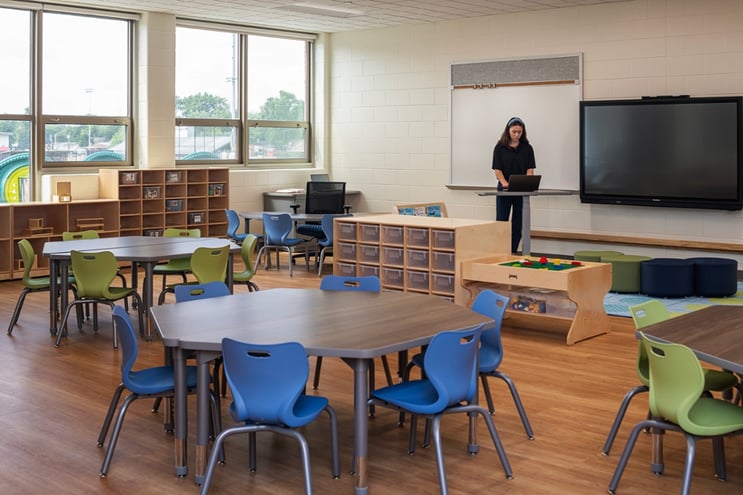QUALITY PRESCHOOL CLASSROOMS
ARE WELL-PLANNED.
Early learners learn through play and communication. The environment should spark their imagination, inviting learning through exploration and collaboration. Reconfigurable spaces are safe and secure and need to meet the demands of a dynamic and active environment. 

As you design your classrooms, think about how the space will function, how it supports the students' learning outcomes, and how it will make students feel. Here are some questions to help guide your discussions: Download the planning guide.

helpful links to CLASSROOM DESIGN TRENDS
- Planning Typicals for Pre-K
- Learning Environments That Promote Student Safety and Security
- Develop Social & Interpersonal Skills with These Classroom Setup Ideas
EXPLORE CLASSROOM SETUP IDEAS
Click through classroom ideas below or visit our image gallery of learning spaces designed to promote comfort, configurability, mobility, and accessibility in a variety of classroom environments.

SOCIAL INTERACTIONS
Sitting on the floor encourages social interaction among children. It facilitates collaborative learning, group discussions, and cooperative play, fostering social skills and teamwork.

LARGE WORK SURFACES THAT PROMOTE SOCIAL INTERACTION
Large activity tables provide a communal space where children can sit together and engage in collaborative activities. This fosters social interaction, communication, and the development of social skills, which are essential for early childhood development.

MUSCLE DEVELOPMENT
Movement seating encourages activities that involve large muscle groups, such as rocking, bouncing, or swaying. These activities contribute to the development of gross motor skills, coordination, and balance.

ENHANCE FOCUS + ATTENTION WITH MOVEMENT SEATING
Many preschoolers have abundant energy, and Artcobell MOV Stools allows them to release some of that energy in a controlled and constructive way. This can lead to increased focus and attention during other seated activities, as children have an outlet for their natural need to move.

TABLES FOR TEACHERS
Replacing a traditional teacher desk in favor of large activity table symbolizes a more inclusive teaching approach. It communicates that the learning space is shared, and the teacher is an active participant in the learning process alongside the students.

"HUDDLE" SPACES
Create a zone where small groups of students can learn and play together in a safe and secure way. Use FLOT chairs and a crescent table at floor height to maintain structure.

MIX UP HEIGHTS
Movement is important to increase respiration and blood flow. Use floor seating and reduced height work surfaces to encourage floor work.
accessible storage
Fostering independence and self-confidence, children need to be able to easily access materials and supplies. Storage should be at eye level. Click through the gallery below to view some additional storage solutions for your preschoolers.

FURNITURE THAT FITS
Choose furniture that is appropriately sized for young children, allowing them to comfortably engage in activities. Opt for open shelving and clear bins to help children easily see and access toys and materials.

STAY ORGANIZED
Assign each child their own cubby or locker for storing personal items, such as jackets, backpacks, and artwork.

DESIGNATED MAKER SPACE
Create a dedicated area within the classroom for the maker space activities. This can be a corner with tables, shelves, and storage for materials.

MOBILE CARTS
Consider using rolling carts with trays or bins to organize and transport materials between different maker space stations. This provides flexibility and allows for easy cleanup.

GATHERING SPOT
Use open shelves to store frequently used materials such as blocks, art supplies, and construction materials. Open shelving allows easy visibility and access for both teachers and students.

COAT + BACKPACK LOCKER
Provide individual storage spaces for each child to keep their belongings.
 CLASSROOM DESIGN MATTERS
CLASSROOM DESIGN MATTERS
Selecting the right furniture for preschool classrooms is essential for creating a safe, comfortable, and engaging learning environment that supports the diverse needs of young learners. It contributes to the overall success of the educational experience and lays the foundation for positive attitudes toward learning.

